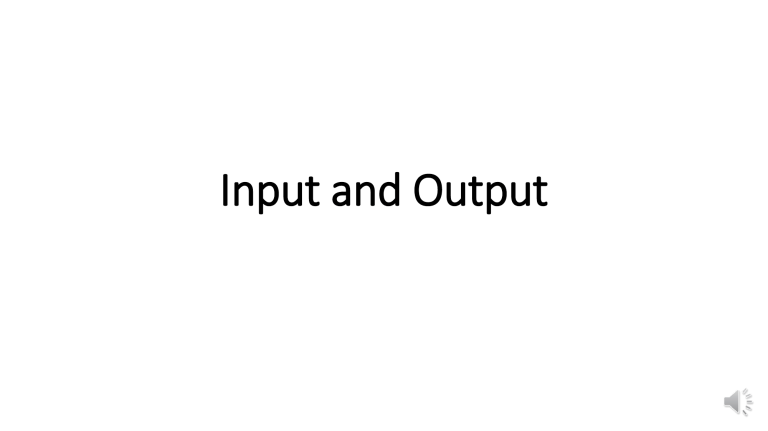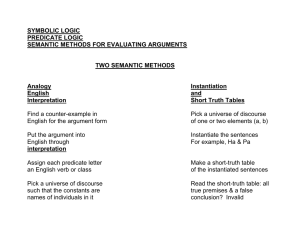
Input and Output
Input and Output
• Prolog has facilities to enable input and output either of terms or of
characters.
• Using terms is simpler and will be described first. Initially, it will be
assumed that all output is to the user's screen and all input is from
the user's keyboard.
• Input and output using external files.
Outputting Terms
• The main built-in predicate provided for outputting terms is write/1,
which has already been used many times in course.
• The write/1 predicate takes a single argument, which must be a valid
Prolog term.
• Evaluating the predicate causes the term to be written to the current
output stream, which by default is the user's screen (At present it can
simply be taken to mean the user's screen.).
Outputting
Terms
• The built-in predicate nl/0
has also been used many
times previously in this
course.
• It takes no arguments.
• Evaluating a nl goal causes a
new line to be output to the
current output stream.
Outputting Terms
• Note that atoms that have to be
quoted on input (e.g. 'Paul', 'hello
world') are not quoted when
output using write.
• If it is important to output the
quotes, the writeq/1 predicate can
be used.
• It is identical to write/1 except
that atoms that need quotes for
input are output between quotes
(other atoms are not).
Example
Inputting Terms
• The built-in predicate read/1 is provided
to input terms. It takes a single
argument, which must be a variable.
• Evaluating it causes the next term to be
read from the current input stream,
which by default is the user's keyboard.
• The meaning of current input stream will
be explained later in more details but at
present it can simply be taken to mean
the user's keyboard.
Inputting Terms
• In the input stream, the term must be
followed by a dot ('.') and at least one white
space character, such as space or newline.
• The dot and white space characters are read
in but are not considered part of the term.
Inputting
Terms
• When a read goal is
evaluated, the input term is
unified with the argument
variable.
• If the variable is unbound
(which is usually the case) it
is bound to the input value.
Inputting
Terms
• If the argument variable is
already bound (which for
most users is far more likely
to occur by mistake than by
design), the goal succeeds if
and only if the input term is
identical to the previously
bound value.
Input and Output Using Characters
• Although input and output of terms is straightforward, the use of
quotes and full stops can be cumbersome and is not always suitable.
• For example, it would be tedious to define a predicate (using read)
which would read a series of characters from the keyboard and count
the number of vowels.
• problems of this kind is to input a character at a time. To do this it is
first necessary to know about the ASCII value of a character
Input and Output
Using Characters
• All printing characters and
many non-printing characters
(such as space and tab) have a
corresponding ASCII (American
Standard Code for Information
Interchange) value, which is an
integer from 0 to 255.
• The table below gives the
numerical ASCII values
corresponding to the main
printable characters and some
others.
• Characters whose ASCII value is
less than or equal to 32 are
known as white space
characters.
Outputting Characters
• Characters are output using the built-in predicate put/1. The
predicate takes a single argument, which must be a number from 0 to
255 or an expression that evaluates to an integer in that range.
• Evaluating a put goal causes a single character to be output to the
current output stream. This is the character corresponding to the
numerical value (ASCII value) of its argument, Example in the next
slide;
Example
• Two built-in predicates are provided to input a single
character: get0/1 and get/1.
• The get0 predicate takes a single argument, which must be a
variable. Evaluating a get0 goal causes a character to be read
from the current input stream.
Inputting
Characters
• The variable is then unified with the ASCII value of this
character.
Inputting Characters
• Assuming the argument variable is unbound
(which will usually be the case), it is bound to
the ASCII value of the input character.
• If the argument variable is already bound,
the goal succeeds if and only if it has a
numerical value that is equal to the ASCII
value of the input character.
• The predicate readin is defined recursively. It causes a single
character to be input and variable X to be bound to its (numerical)
ASCII value.
• The action taken (the process(X) goal) depends on whether or not X
has the value 42 signifying a * character.
• If it has, the evaluation of the goal stops. If not, the value of X is
output, followed by a new line, followed by a further call to readin.
• This process goes on indefinitely until a * character is read.
Input and Output Using Files
• The user may open and close input and output streams associated
with any number of named files but there can only be one current
input stream and one current output stream at any time.
• Note that no file can be open for both input and output at the same
time (except user) and that the user input and output streams cannot
be closed.
File Output: Changing the Current Output
Stream
• The current output stream can be changed using the tell/1 predicate.
This takes a single argument, which is an atom or variable
representing a file name, e.g. tell('outfile.txt').
• Evaluating a tell goal causes the named file to become the current
output stream.
• If the file is not already open, a file with the specified name is first
created (any existing file with the same name is deleted).
• Note that the file corresponding to the previous current output
stream remains open when a new current output stream is selected.
told/0 and telling/1
• The built-in predicate told/0 takes no arguments. Evaluating a told
goal causes the current output file to be closed and the current
output stream to be reset to user, i.e. the user's terminal.
• The built-in predicate telling/1 takes one argument, which must be a
variable and will normally be unbound. Evaluating a telling goal
causes the variable to be bound to the name of the current output
stream.
File Input: Changing the Current Input Stream
• The current input stream can be changed using the see/1 predicate. This
takes a single argument, which is an atom or variable representing a file
name, e.g. see('myfile.txt').
• Evaluating a see goal causes the named file to become the current input
stream.
• If the file is not already open it is first opened (for read access only).
• If it is not possible to open a file with the given name, an error will be
generated.
• Note that the file corresponding to the previous current input stream
remains open when a new current input stream is selected.
• Only the current input stream can be closed (using the seen predicate described
below).
seen/0 and seeing/1
• The built-in predicate seen/0 takes no arguments. Evaluating a see goal causes the
current input file to be closed and the current input stream to be reset to user, i.e. the
user's terminal.
• The built-in predicate seeing/1 takes one argument, which must be a variable and will
normally be unbound. Evaluating a seeing goal causes the variable to be bound to the
name of the current input stream.
Reading from Files: End of File
• If the end of file is encountered when evaluating the goal read(X),
variable X will be bound to the atom end_of_file.
• If the end of file is encountered while evaluating the goal get(X) or
get0(X), variable X will be bound to a 'special' numerical value.
• As ASCII values must be in the range 0 to 255 inclusive, this will
typically be -1, but may vary from one implementation of Prolog to
another
Reading from Files: End of Record
• Depending on the version of Prolog used, there may be an
incompatibility for character input between reading the end of a
record (i.e. the character(s) that signify the end of a line) from the
user's terminal and from a file.
• Typically the end of a line of input at the user's terminal will be
indicated by the character with ASCII value 13. The end of a record in
a file will generally be indicated by two ASCII values: 13 followed by
10.
• The following program shows how to read in a series of characters
from the keyboard and print them out, one per line.
Reading from
Files: End of
Record
Using Files: Examples
• Define a predicate copychars to copy characters input (as a single
line) at the user's terminal to a specified file, until the character ! is
entered (this character should not be copied).
• In the program below, copychars mainly saves and restores the values
of the current input and output streams.
• The rest of the task is left to copy_characters, which is defined
recursively in a similar way to readin.
Using Files: Examples


